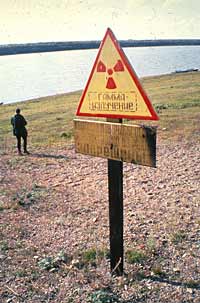
New Managing Director for Bellona Norway
The Board of the Bellona Foundation has appointed former Minister of Climate and the Environment Sveinung Rotevatn as Managing Director of Bellona No...
News

Publish date: October 2, 2001
Written by: Rashid Alimov
News
On July 23rd a court decision was voiced on the suit of 26 claimants from the village Georgievka against the Siberian Group of Chemical Enterprises (SGCE, also known as the Siberian Chemical Combine). Georgievka, situated in Tomsk county, western Siberia, suffered from the accident at a SGCE plant on April 6th 1993, which caused radioactive contamination of the area. During the court hearings 14 claimants died. The aggrieved claimants demanded indemnity for moral damage from SGCE and the Tomsk county administration. Furthermore, they demanded that SGCE would cease to dump liquid radioactive waste into underground geological formations.
Unconfirmed reports suggest that a radioactive waste release on April 6th 1993 was caused by French spent nuclear fuel reprocessing, under the contract with the French nuclear company Cogema, because isotopic composition of the fuel fell beyond the plant’s technical capabilities designed solely for Russian fuel. The surrounding territory was contaminated within a radius of 25 km.
The county court admitted that the accident was a serious moral injury, as it caused radioactive contamination of Georgievka and its outskirts. After the accident measurements were taken resulting in farms being decontaminated, signs indicating radioactive danger were put up at the village boundaries and pasture and harvesting were banned.
The Tomsk administration was not found responsible, but the court made SGCE pay each claimant an indemnity of $860. At the same time however, the court permitted the combine to continue underground disposals of liquid radioactive waste. Both parties disagree with the court, and are going to appeal the decision.
Several days before the trial was over, the Nuclear State Regulatory (GAN) granted SGCE license for dumping liquid radioactive waste in geological formations. The claimants said, the large-scale dumping in the underground, water-bearing injection wells of between 280 to 400 meters deep, contradicts with the Russian legislation (articles 7 and 104 of the Russian Water Code, art. 54.3 of the Law on Environmental Protection).
–>
The case was first examined by the court of the closed city of Seversk, but was in February 2001 transferred to the Tomsk County Court, because the defendants referred to some classified documents regulating dumping of radioactive waste underground. The cases, which are related to state secrets, can be examined either by the Supreme Court of the Russian Federation, or by a county court.
The lawyer pleading for the Georgievka inhabitants, Konstantin Lebedev, commented upon the current situation for the Bellona Web:
– The sides are examining the motivation behind the verdict, and may lodge a complaint within 10 days. The claimants are going to appeal the decision allowing SGCE to continue its illegal and dangerous activities. Furthermore, we will appeal the court decision relieving the Tomsk administration of responsibility. The verdict, which includes strange inaccuracies like calling the signs of radioactive danger signs of radioactive safety, provokes us to lodge complaints.
In an additional writ from April 13th 1999, the claimants said the radiation release of April 6th 1993 did not have the most significant impact on the radioactive and chemical contamination of the area. The accident only partly lifted the veil of secrecy, surrounding the SGCE activities.
Under normal operation the combine releases 10 grams plutonium into the atmosphere annually, whereas one millionth of a gram may cause serious diseases if consumed by humans. The soils and waters contain chemicals, and the level of beta-activity in the atmosphere is four to ten times higher than the natural level.
During the 30 years that the Siberian Chemical Combine has been in operation, the production of weapons grade plutonium and the enrichment of uranium have resulted in large amounts of radioactive waste. Solid and liquid waste are either stored or placed into permanent repositories at various sites within the enclosed areas of the Combine. There are 50 different storage areas within the borders of SCC that receive solid and liquid waste generated by the plant’s activities. The two forms of waste together have a total activity of 4,6 million TBq (125 MCi). There is also a great deal of liquid waste which has been either deposited down into sandy beds 320-460 m deep or else pumped into open holding pools.
There have been about 30 accidents during the combines 50-year history. The last major accident happened on June 14th 1999, when an operators fault caused contamination of the plant, and two workers were exposed to a radiation dose exceeding the annual radiation tolerance three times.

The Board of the Bellona Foundation has appointed former Minister of Climate and the Environment Sveinung Rotevatn as Managing Director of Bellona No...

Økokrim, Norway’s authority for investigating and prosecuting economic and environmental crime, has imposed a record fine on Equinor following a comp...

Our op-ed originally appeared in The Moscow Times. For more than three decades, Russia has been burdened with the remains of the Soviet ...

The United Nation’s COP30 global climate negotiations in Belém, Brazil ended this weekend with a watered-down resolution that failed to halt deforest...